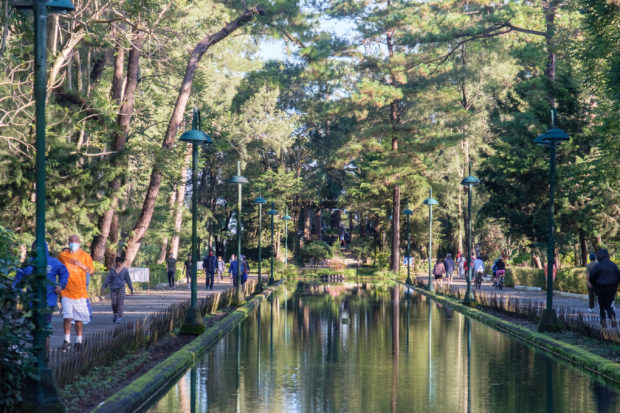‘Breathe Baguio’ campaign promotes summer capital as health sanctuary

MOUNTAIN AIR The pond area fronting the presidential Mansion at Wright Park has become a popular jogging and walking path where Baguio City residents and visitors enjoy the fresh mountain air. —NEIL CLARK ONGCHANGCO
BAGUIO CITY—This city has designed a new tourism marketing brand that embraces its multicultural history and its origins as a health sanctuary when it was first developed in the early 1900s by the American colonial government.
The “Breathe Baguio” campaign evokes how Baguio started out as a colonial hill station, one of the high-elevation communities created by American colonizers as a summer refuge in Asia, which remained relevant as the country struggles with a second year of the coronavirus pandemic, said Aloysius Mapalo, city tourism officer.
Baguio was designed and built by Chicago architect Daniel Burnham to serve as the seat of the American colonial government during summer when sweltering heat swept through Manila. Chartered in 1909, the city had since become the finance, education and industrial hub of the Cordillera, with a population of more than 366,000.
The new city brand would be officially launched on Sept. 1 when Baguio holds a low-key commemoration of its 121st foundation day.
Dwindling tourists
Leisure businesses absorbed P1.6 billion in losses from the first hard lockdown last year because of the pandemic, Mapalo said.
Article continues after this advertisementFrom the time Baguio officially reopened its borders to leisure travel in October last year until Aug. 22 this year, hotels, restaurants and other tourism-oriented enterprises served only 123,000 guests, he said.
Article continues after this advertisementBaguio did not receive visitors in the last week of March and the early weeks of April due to a spike in COVID-19 cases. But border controls soon eased and despite the detection of the Delta variant, 130 tourists still visited the city from Aug. 16 to Aug. 22.
According to Mapalo, “Breathe Baguio” was picked out from a pool of concepts that included “Walk in Baguio” and “Baguio Life in Color.”
‘Sentimentality’
A group of artists, architects and marketing professionals settled on “Breathe Baguio” because it draws out “sentimentality over old Baguio,” he said during a city council session last week. The logo uses a font that mimics Cordillera tribal shields, with angular corners “inspired by Cordillera patterns and American Art Deco,” Mapalo said. A stem of the Baguio flower, everlasting, dangles above the word “Baguio” to promote the city’s “perpetuity.”
It would be applied in marketing narratives about Baguio culture, creativity, nature and wellness.
“Breathe Wellness,” for instance, advertises Baguio as a place where people can immerse themselves away from the lockdowns in order to heal “the body, mind and soul.” —VINCENT CABREZA